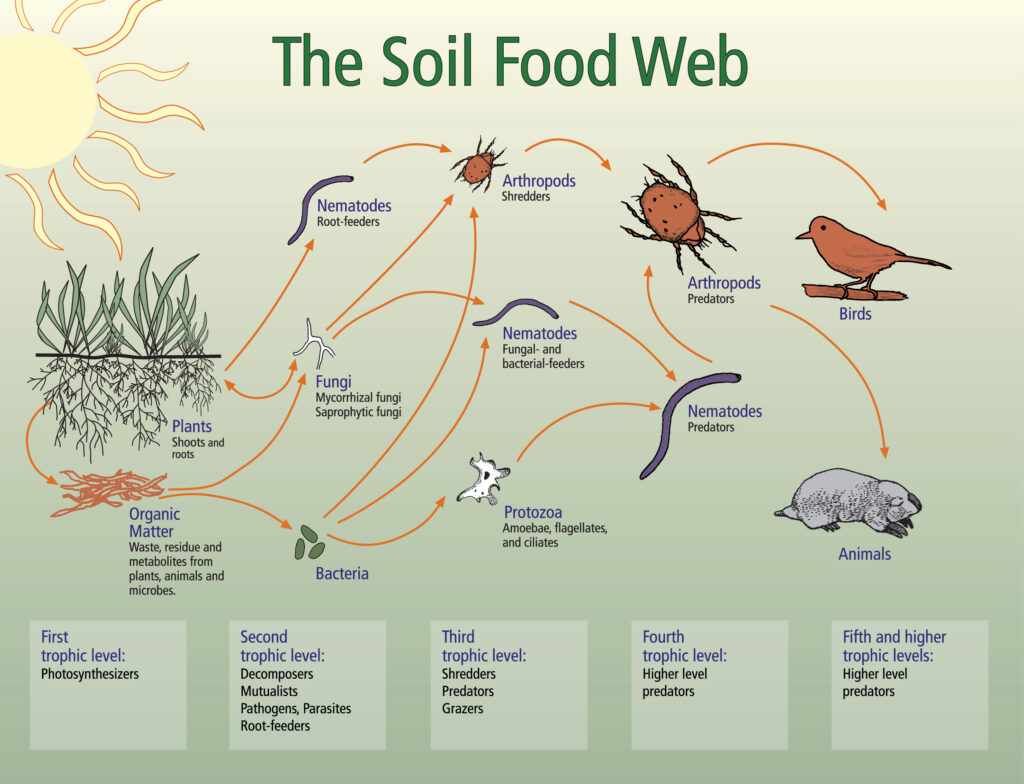Soil Food Web:
Information and Infographics
Why use biologically complete compost?
Sadly we humans have done a good job of disturbing much of the planet’s soils in a significant way. Over a long time, nature can and will repair itself. Thankfully, with the right intervention, we can greatly speed up the process by inoculating soils with beneficial organisms. This will help set our managed soils on a better path for growing the plants that we desire. Using composts that are high in biological diversity and abundant in numbers is more about quality than quantity. A little can go a long way!
Different plants evolved with differing fungi to bacteria (F:B) ratios. Therefore, depending on which kinds of plants you are trying to grow, the community of organisms in the soil will look different. City lawns, vegetable gardens, pastureland, old-growth forests, row crops, and prairie all have their preferences in terms of the underground community.
What exactly is the soil food web?
The soil food web (SFW) is an incredibly diverse and complex set of organisms that live mainly in soils and also completely cover the surfaces of healthy plants. There are different trophic levels in the soil but instead of a pyramid, the arrangement is better compared to an interconnected web. Included in the matrix are bacteria, fungi, algae, protozoa (amoebae, flagellates, and ciliates), nematodes, microarthropods, worms, insects, and more. Of course, plants play a vital role, too! While we still have so much to learn about the soil and its interactions with plants, we have come a long way in our understanding of the interconnectivity of life since the start of modern-day agriculture.
Interactions
In a healthy soil environment where plants grow alongside aerobic soil microorganisms, a lot is going on. Consider the following:
- Organic matter (root exudates and plant material) becomes food for bacteria and fungi.
- Nutrient cycling occurs naturally when bacteria and fungi are eaten by larger organisms. This consumption conveniently releases nutrients in a plant-available form right around the plants’ roots.
- Nutrient retention in healthy soils occurs because organisms take up and store nutrients in their bodies. When this happens the nutrients don’t leach away when water flows through the soil.
- Coverage of aerobic microorganisms on plant surfaces helps to reduce pressure from disease-causing fungi and bacteria and insect pests.
- Soil structure is built from bacteria and fungi sticking sand, silt, clay, and plant organic matter together.
Benefits of increasing soil biology
- No more need for: Fertilizers, Pesticides, Herbicides, Fungicides , Other soil amendments
- With the above in mind, these kinds of products can still be used in conjunction with soil biology while still achieving beneficial plant responses
- Eliminate tillage (if desired, though not necessary)
- Decrease water use/irrigation (more water holding capacity)
- Decrease compaction/increase soil structure
- Increase crop yields
- Improve quality of crops harvested (healthy plants = healthy food)
Helpful Graphics


